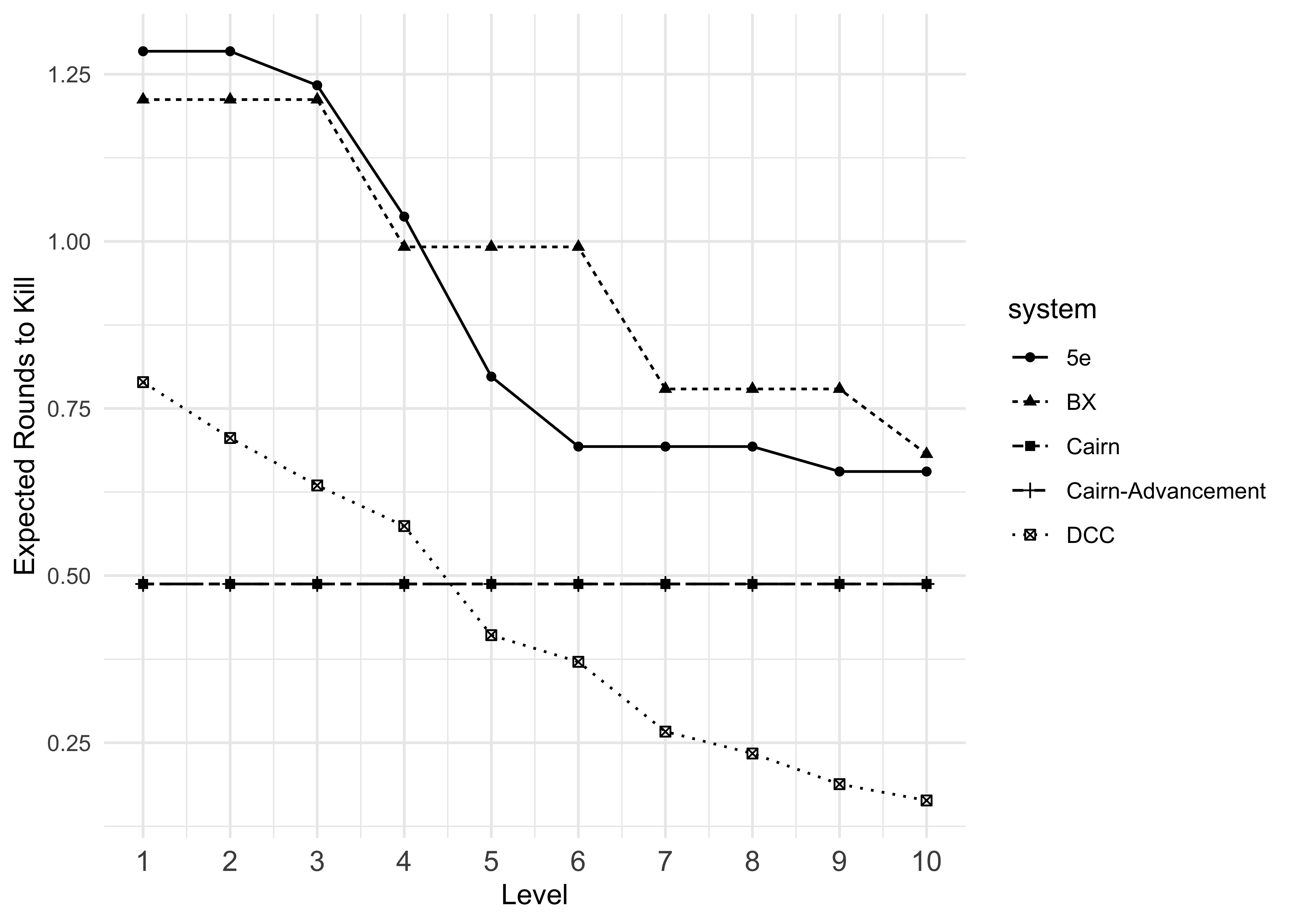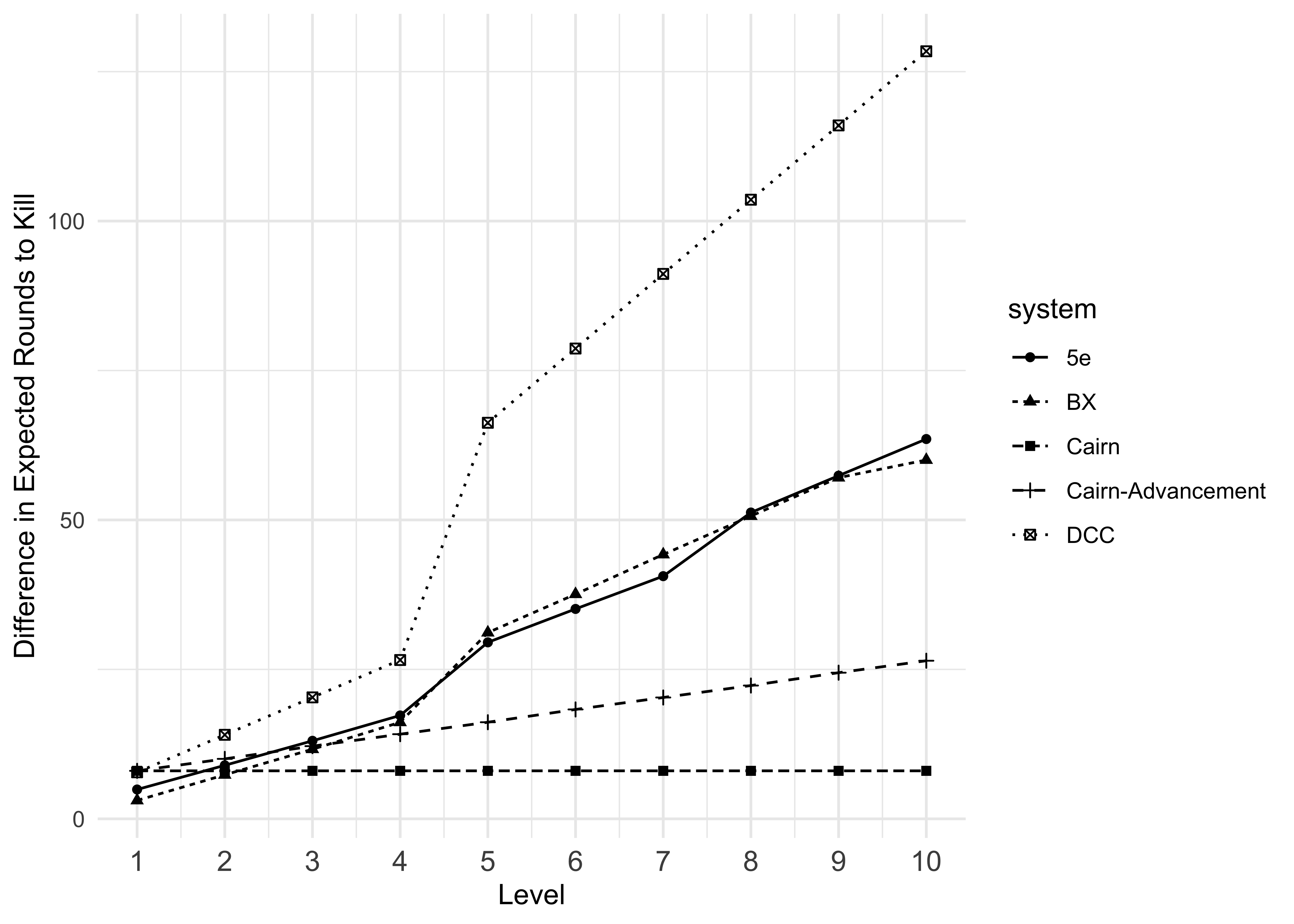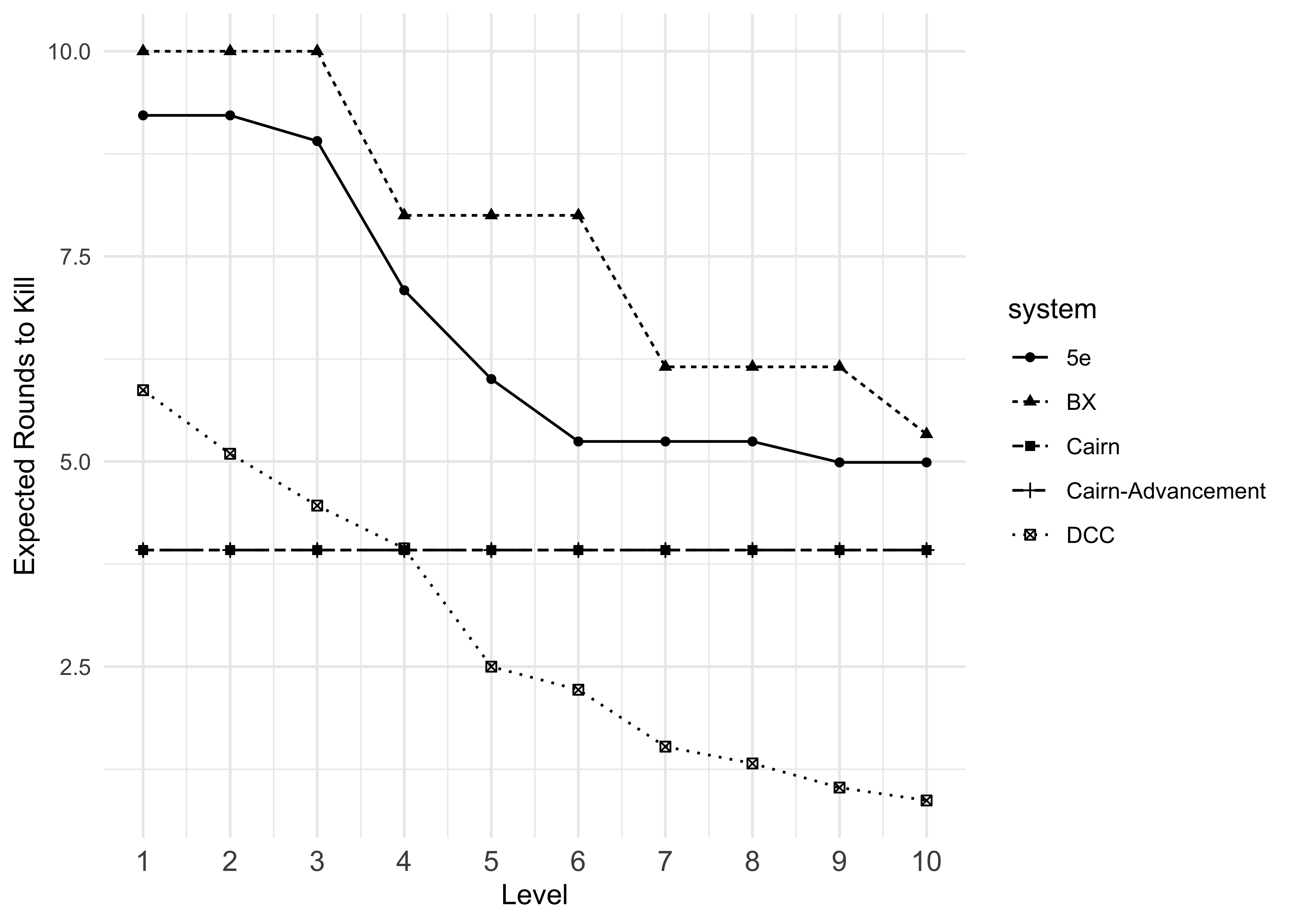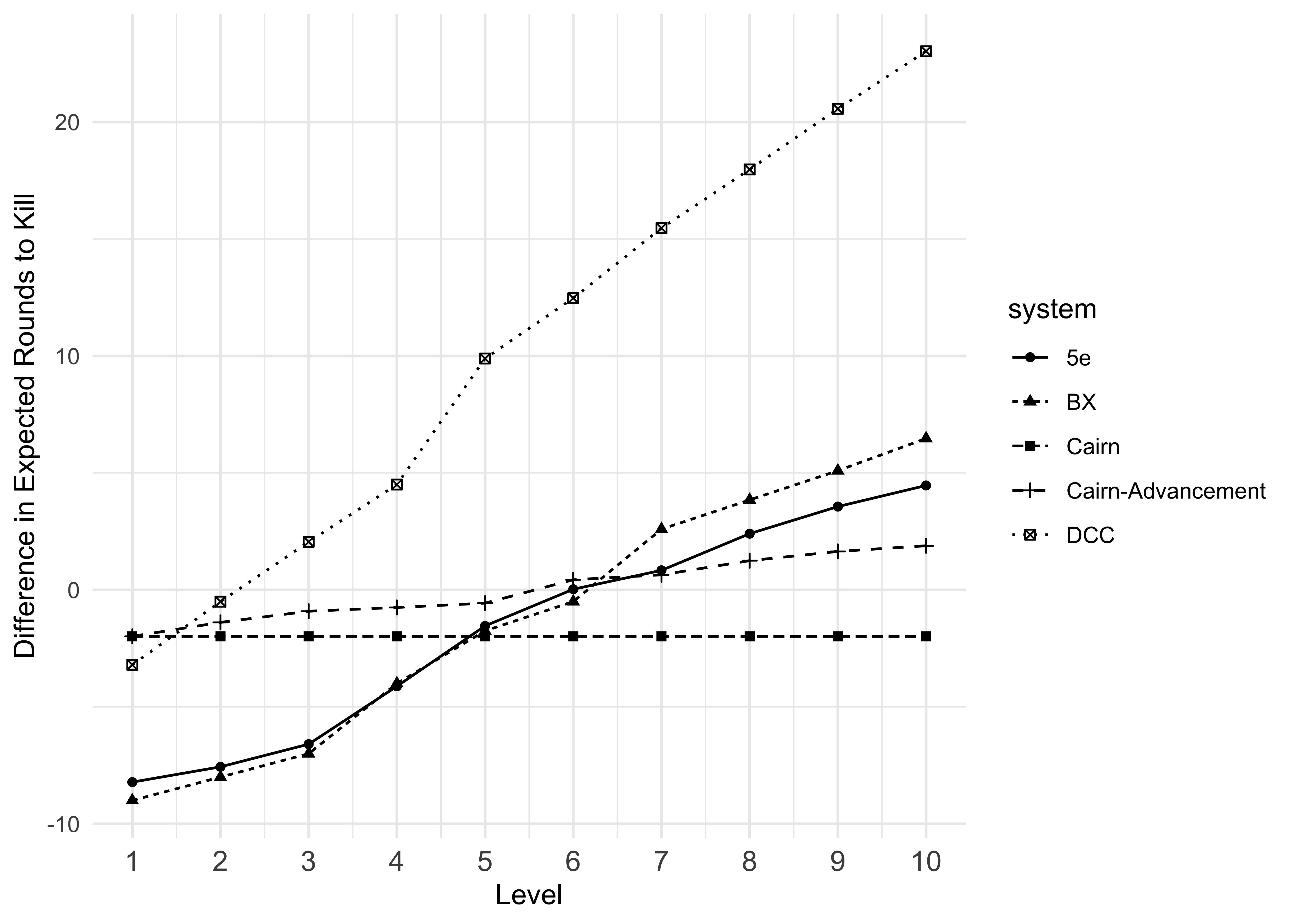Cairn Damage Analysis
Published:
I recently got to run Cairn for the first time and it was a blast. I really enjoyed the auto-hit mechanic, inventory management, and generally simple rules. Bonus points for not using Vancian casting (we used the GLoG magic option).
Cairn has a reputation for very fast and deadly combat, which matched the experience of our one-shot. It got me thinking though how a Fighter in Cairn stacks up against similar PCs in other systems. Cairn doesn’t have classes, but I wanted to see how a martially-focused Cairn character performs against some standard monsters in comparison to games I have played a fair bit: BX, 5e, DCC.
Let’s get to it!
Assumptions
I tried to keep the comparison across systems fair, i.e., I relied on a simple fighter and two canonical monsters that appear across systems.
Here are a few things I ignore: magic items, “combat as war” considerations, and morale. All of these things are available, at least as optional rules, in all four systems and would complicate the comparison of mechanical damage.
In each case, I calculate the expected damage per round against the creature (including crit damage if it is part of the system). I then compare the expected PC damage per round to the monster HP to determine the expected number of rounds until death. This straightforward for BX, 5e, and DCC and boils down to the ratio of monster HP and expected damage per round by the PC. It’s a bit trickier for Cairn because monsters get a STR save when reaching 0 HP to stay in the fight. To figure out the expected number of rounds until monster death, I had first calculate the expected number of rounds the monster will stay alive based on HP and then add the expected number of additional turns based on the probability of passing STR saves.
Apart from calculating the offensive potential of a PC, I also look at the damage the monster can return per round relative to PC AC/armor and HP/STR. To get at the overall offensive+defensive performance, I calculate the net difference in expected rounds until death (Monster expected rounds - PC expected rounds). Positive numbers indicate the PC killing the monster before being killed (in terms of rounds before the monster wins). Negative numbers indicate the monster winning.
BX
I use a standard Fighter (level 1-10) with STR 13 and CON 12. The Fighter uses a longsword+shield. For armor, the Fighter uses chain mail from level 1-4 and full plate from level 5-10.
The Fighter faces a canonical Goblin and an Owlbear. The Owlbear uses its two claw attacks.
DCC
I use a standard DCC Warrior with STR 13 and STA 12. The Warrior steps up the Mighty Deed die according to the progression table and increases their crit range (I assumed a simple +1d6 extra damage on a crit–probably conservative). The DCC Warrior also gains extra Action Dice (=extra attacks) at various levels.
The Warrior uses longsword+shield and wears chain mail until level 5, then full plate. Armor scales slightly differently in DCC than BX.
Because the DCC Goblin is especially puny, I used the BX goblin. I used the DCC Owlbear (with two claw attacks) for the second comparison.
5e
I assumed a Champion Fighter with STR 16 and CON 16. I used ASIs to first increase STR to max, then CON. I picked the dueling fighting style. The Fighter also uses a longsword+shield and wears chain mail until level 5, then full plate. I account for the Extra Attack feature at level 5, but ignore Action Surge and Second Wind.
I use the standard 5e Goblin and Owlbear.
Cairn
To mimic a standard Fighter, I assume a STR 13 and give the character a longsword+shield and additional armor (for a total armor of 3 throughout). There is no mechanical advancement in Cairn, so I keep the stats the same throughout.
I use the Goblin and Owlbear from the Cairn website.
I also include a comparison for a version of Cairn based on Spellburn & Battlescars that features some advancement. HP increases by 1 “per level” (I assume 1 level in the other systems is equal to one instance of advancement in Cairn/SB) and I increase STR by 3 points total (to 16) over the course of 10 “levels”. This only affects the defensive capabilities of the character.
Results
Goblin
In terms of pure offense, both DCC and Cairn allow Fighters right from the start to put a lot of hurt on a single goblin. Fighters in DCC and Cairn can expect to kill a goblin within the first round. BX and 5e Fighters will need, in expectation, two rounds to get the job done.
As the Fighter increases their level, we see fairly linear progression in terms of offense in BX, DCC, and 5e. Cairn remains flat in its damage output (by design), but stays ahead of both BX and 5e throughout Levels 1-10.
Notably, BX and 5e track fairly closely with each other. DCC Warriors become true killing machines at level 5 and outpace the deadliness of Cairn Fighters when facing a goblin.

Considering the damage output of a Fighter relative to the damage output of the goblin, we see an even stronger advantage of the DCC warrior. This is largely because the DCC Warrior scales in terms of damage like a 5e Fighter, but has more HP and AC than a BX warrior and faces BX-like goblins (whereas as 5e Fighter has to deal with a stronger goblin).

Cairn stays flat (by design), while Cairn with SB advancement sees a bit of improvement over levels, because the slightly higher HP and STR increase the survivability in this variant. It is striking though that Cairn Fighters do not remain far ahead of a goblin no matter the level, i.e., goblins remain a serious threat throughout. In contrast, a Fighter in BX, 5e, and DCC will face close to zero risk from fighting a goblin after level 1 or 2.
Again, it is striking how closely a 5e Fighter tracks the classic BX Fighter.
Owlbear
Looking at the Owlbear, we see a similar pattern in terms of PC damage outputL Cairn and DCC Warriors have high damage output relative to monster HP and stay ahead of BX and 5e.

In terms of net outcomes, Owlbears are likely to kill a single Fighter until about level 5 in BX and 5e. DCC Warriors can expect to best an Owlbear in single combat at around level 2 (a DCC Owlbear has very few HP compared to the other systems).
A standard Cairn Fighter is always expected to lose against an Owlbear. A Cairn Fighter with advancement will have a chance against an Owlbear after around six advancements.

Conclusion
BX and 5e are remarkably similar in terms of offensive and net damage scaling. 5e has a bad reputation for slow combat and HP bloat. I am not sure if that is warranted, at least in terms of the HP-damage balance (and I used a pretty basic 5e Fighter–a minimally optimized character would end combats even quicker). In terms of mechanically hacking down a monster, 5e is very comparable to BX (to which you might say: yes! BX can be super whiffy and sluggish when facing high-HP monsters).
The DCC Warrior is an absolute killing machine! No wonder I like this class so much.
Fighters in Cairn can end fights very quickly when facing low-HD monsters. The auto-hit, damage-reducing-armor, and high STR of a martial character in Cairn is a very effective combination. At the same time, risk of death is always present in Cairn–while in other games goblins eventually become totally ineffective against high-level PCs, they remain a threat in Cairn. In addition, the lack of damage scaling makes for an entirely different risk profile in combat over the life-time of a character. Cairn Fighters that have survived several adventures and are the equivalent of a high-level PC in a leveled game, are not much better at facing low-level monsters and at an incredible disadvantage when facing up against more dangerous creatures. I think this just underscores several things:
Cairn is fundamentally different in terms of its combat risk profile.
GMs really have to think about diegetic improvements.
I think there might be a particular challenge in Cairn to integrate high-level monsters or convert high-level adventures from BX or 5e–Cairn PCs have little mechanical ability to confront some of those threats, even less so than in other OSR systems.
